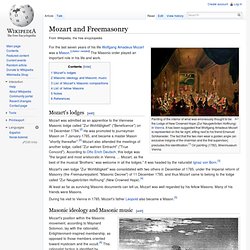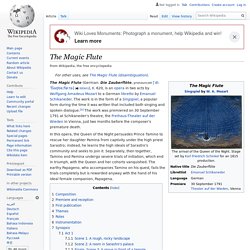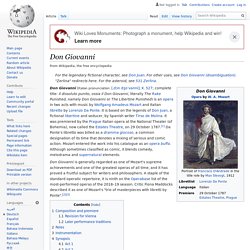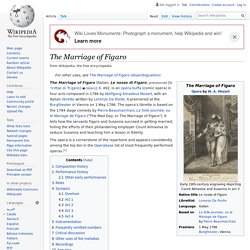

Www.wisdomlib. Introduction: Mahatejas means something in Hinduism, Sanskrit.

If you want to know the exact meaning, history, etymology or English translation of this term then check out the descriptions on this page. Add your comment or reference to a book if you want to contribute to this summary article. Shaivism (Shaiva philosophy) Source: Wisdom Library: Śaivism Mahātejas (महातेजस्) is the Sanskrit name of a deity presiding over Śaṅkukarṇa, one of the sixty-eight places hosting a svāyambhuvaliṅga, which is one of the most sacred of liṅgas according to the Śaivāgamas.
Shaiva (शैव, śaiva) or Shaivism (śaivism) represents a tradition of Hinduism worshiping Shiva as the supreme being. Purana and Itihasa (epic history) Source: archive.org: Puranic Encyclopedia Mahātejas (महातेजस्). Source: archive.org: Shiva Purana - English Translation. The Royal Opera: Mozart - The Magic Flute (FULL) En.m.wikipedia. Painting of the interior of what was erroneously thought to be the Lodge of New Crowned Hope (Zur Neugekrönten Hoffnung) in Vienna.

It has been suggested that Wolfgang Amadeus Mozart is represented on the far right, sitting next to his friend Emanuel Schikaneder. The fact that the two men wear a golden angle (an exclusive insignia of the chairman and the first supervisor) precludes this identification.[1] Oil painting (1782), Wienmuseum Vienna. For the last seven years of his life Wolfgang Amadeus Mozart was a Mason. [citation needed] The Masonic order played an important role in his life and work. Mozart's lodges[edit] Www.operanorth.co. What is this production like?

In this new production by director James Brining and designer Colin Richmond, every scene is a visually engaging feast! The set is deceptively simple, with walls that shape-shift and move as the story progresses, creating a feeling of unsettlement and dreaminess. Projections (by Douglas O’Connell) throw some extra magic on proceedings and pull the audience a little more into the fantastical world in which this piece is set. Inventive costumes blend fantasy and reality, with influences ranging from Dr Who to Black Mirror, but in the end, it’s all about representing the psychology behind each character. Www.britannica. Act I Scene 1.

Prince Tamino, lost in a wild forest, is being pursued by a giant serpent. Www.classicfm. Www.metopera. A mythical land between the sun and the moon.

Www.mozart. Mozart had fallen on hard times.

He was constantly worried about money and Constanze’s health and struggled with feeling not fully appreciated. 1790 was a hard year. Like so often he composed just for the sake of composing – having no official commissions. En.m.wikipedia. The Magic Flute (German: Die Zauberflöte, pronounced [ˈdiː ˈt͡saʊ̯bɐˌfløːtə] ( listen)), K. 620, is an opera in two acts by Wolfgang Amadeus Mozart to a German libretto by Emanuel Schikaneder.

The work is in the form of a Singspiel, a popular form during the time it was written that included both singing and spoken dialogue. [a] The work was premiered on 30 September 1791 at Schikaneder's theatre, the Freihaus-Theater auf der Wieden in Vienna, just two months before the composer's premature death. In this opera, the Queen of the Night persuades Prince Tamino to rescue her daughter Pamina from captivity under the high priest Sarastro; instead, he learns the high ideals of Sarastro's community and seeks to join it. Separately, then together, Tamino and Pamina undergo severe trials of initiation, which end in triumph, with the Queen and her cohorts vanquished. En.m.wikipedia. Italian-language opera buffa by W.

A. Mozart Così fan tutte, ossia La scuola degli amanti[a] (All Women Do It, or The School for Lovers), K. 588, is an Italian-language opera buffa in two acts by Wolfgang Amadeus Mozart first performed on 26 January 1790 at the Burgtheater in Vienna, Austria. The libretto was written by Lorenzo Da Ponte who also wrote Le nozze di Figaro and Don Giovanni. The short title, Così fan tutte, literally means "So do they all", using the feminine plural (tutte) to indicate women.
Performance history[edit] En.m.wikipedia. Don Giovanni is generally regarded as one of Mozart's supreme achievements and one of the greatest operas of all time, and it has proved a fruitful subject for writers and philosophers.

A staple of the standard operatic repertoire, it is ninth on the Operabase list of the most-performed operas of the 2018–19 season. Critic Fiona Maddocks described it as one of Mozart's "trio of masterpieces with libretti by Ponte".[2][3] Composition and premiere[edit] Original playbill for the Vienna premiere of Don Giovanni. En.m.wikipedia. The Marriage of Figaro (Italian: Le nozze di Figaro, pronounced [le ˈnɔttse di ˈfiːɡaro] ( The opera is a cornerstone of the repertoire and appears consistently among the top ten in the Operabase list of most frequently performed operas.[1] Composition history[edit] The opera was the first of three collaborations between Mozart and Da Ponte; their later collaborations were Don Giovanni and Così fan tutte.

It was Mozart who originally selected Beaumarchais's play and brought it to Da Ponte, who turned it into a libretto in six weeks, rewriting it in poetic Italian and removing all of the original's political references. The-relationship-between-mozart-and-lorenzo-da-ponte-1. At certain creative junctures, even the greatest of artistic minds depend on empathetic collaborators to unlock their true potential – that is perhaps the pivotal lesson to be learned from the run of three masterful operas Wolfgang Amadeus Mozart penned alongside librettist Lorenzo Da Ponte, in just four short years.
Taken collectively, The Marriage of Figaro, Don Giovanni and Così Fan Tutte are often hailed as not just the composer’s, but the operatic genre’s, highest aesthetic achievements – and each is set to be presented for the first time at Dubai Opera over two coming weekends. Starting on September 7, the Teatro Di San Carlo’s six-night run arguably represents the venue’s greatest commitment to the field of music so far. Following earlier touring visits from the Welsh National Opera and compatriots Fondazione Teatro Lirico Giuseppe Verdi, the Napoli company will present specially commissioned new productions – an unprecedented investment in bringing opera to the Gulf.
Read more: En.m.wikipedia. The term Da Ponte operas describes the three operas composed by Mozart based on libretti by Lorenzo da Ponte. These works are: Literature[edit] External links[edit] En.m.wikipedia. Lorenzo Da PonteEngraving by Michele Pekenino after Nathaniel Rogers Lorenzo Da Ponte[a] (born Emanuele Conegliano 10 March 1749 – 17 August 1838[4]) was an Italian, later American opera librettist, poet and Roman Catholic priest.
He wrote the libretti for 28 operas by 11 composers, including three of Mozart's most celebrated operas, The Marriage of Figaro (1786), Don Giovanni (1787), and Così fan tutte (1790). Early career[edit] Lorenzo Da Ponte was born Emanuele Conegliano in 1749 in Ceneda in the Republic of Venice (now Vittorio Veneto, Italy). 700. Avertissement de redirection. M.youtube. M.youtube. En.m.wikipedia. La clemenza di Tito (English: The Clemency of Titus), K. 621, is an opera seria in two acts composed by Wolfgang Amadeus Mozart to an Italian libretto by Caterino Mazzolà, after Pietro Metastasio. It was started after the bulk of Die Zauberflöte (The Magic Flute), the last opera that Mozart worked on, was already written.
The work premiered on 6 September 1791 at the Estates Theatre in Prague. Background[edit] In 1791, the last year of his life, Mozart was already well advanced in writing Die Zauberflöte by July when he was asked to compose an opera seria. The commission came from the impresario Domenico Guardasoni, who lived in Prague and who had been charged by the Estates of Bohemia with providing a new work to celebrate the coronation of Leopold II, Holy Roman Emperor, as King of Bohemia. M.youtube. En.m.wikipedia. Die Entführung aus dem Serail (German: [diː ʔɛntˈfyːʁʊŋ ʔaʊ̯s deːm zɛˈʁaɪ̯l]) (K. 384; The Abduction from the Seraglio; also known as Il Seraglio) is an opera Singspiel in three acts by Wolfgang Amadeus Mozart. The German libretto is by Gottlieb Stephanie, based on Christoph Friedrich Bretzner's Belmont und Constanze, oder Die Entführung aus dem Serail. The plot concerns the attempt of the hero Belmonte, assisted by his servant Pedrillo, to rescue his beloved Konstanze from the seraglio of Pasha Selim.
The work premiered on 16 July 1782 at the Vienna Burgtheater, with the composer conducting. Origins[edit] En.m.wikipedia. M.youtube. M.youtube. M.youtube. M.youtube. En.m.wikipedia. M.youtube. M.youtube. En.m.wikipedia. Www.britannica. The Marriage of Figaro, Italian Le nozze di Figaro, comic opera in four acts by Austrian composer Wolfgang Amadeus Mozart (Italian libretto by Lorenzo Da Ponte), which premiered in Vienna at the Burgtheater on May 1, 1786.
Based on Pierre-Augustin Caron de Beaumarchais’s 1784 play Le Mariage de Figaro, Mozart’s work remains a favourite in the operatic repertoire. Britannica Quiz Instrumentation: Fact or Fiction? A glockenspiel is a small piano. Background and context In 1782, as Mozart was making his way as a composer in Vienna, Count Orsini-Rosenberg, director of the Burgtheater (the imperial theatre), invited him to write an opera buffa. En.m.wikipedia. Www.britannica. Avertissement de redirection. M.youtube. M.youtube. M.youtube. M.youtube. Avertissement de redirection. M.youtube. M.youtube. M.youtube. Www.britannica. Piano Sonata No. 11 in A Major, K 331, three-movement sonata for solo piano by Wolfgang Amadeus Mozart, written 1781–83. It is best known for its third movement, written “in the Turkish style,” which is often heard in transcriptions for instruments other than the piano.
Britannica Quiz Lifting the Curtain on Composers: Fact or Fiction? Ludwig van Beethoven was married six times. Mozart composed about 20 solo piano sonatas, from roughly 1775 through the summer of 1789. The sonata’s first movement, “Andante grazioso,” is a theme and six variations. Betsy Schwarm. Avertissement de redirection. M.youtube. M.youtube. M.youtube. Www.britannica. Requiem in D Minor, K 626, requiem mass by Wolfgang Amadeus Mozart, left incomplete at his death on December 5, 1791.
Until the late 20th century the work was most often heard as it had been completed by Mozart’s student Franz Xaver Süssmayr. Later completions have since been offered, and the most favourably received among these is one by American musicologist Robert D. Redirect Notice. M.youtube. M.youtube. M.youtube. M.youtube. Avertissement de redirection. M.youtube. Www.britannica. Exsultate, Jubilate, K 165, (Latin: “Rejoice, Be Glad”) three-movement motet (short sacred composition for voice sung with or without an orchestra) written by Wolfgang Amadeus Mozart in 1773, when the composer was still in his teens.
(A revision of the instrumentation and text followed in 1779 or 1780.) Britannica Quiz A Study of Music Which of these refers to a singing style? Employed from his earliest years by Count Sigismund von Schrattenbach, the prince-archbishop of Salzburg, young Mozart wrote much sacred music. The text, of unknown authorship, is rife with gladness, and Mozart ably captured this joyful mood in his music. En.m.wikipedia. Exsultate, jubilate (Exult, rejoice), K. 165, is a 1773 motet by Wolfgang Amadeus Mozart. History[edit] M.youtube. M.youtube. M.youtube. Www.redlandssymphony. Redirect Notice. Avertissement de redirection. M.youtube. M.youtube. M.youtube. M.youtube. Redirect Notice. M.youtube. M.youtube. M.youtube. M.youtube. Avertissement de redirection. M.youtube. M.youtube. Blackamoor. English[edit] Alternative forms[edit] blackamore, blackemore, blackemoorblackymore (Scotland)blackmoor (obsolete) Etymology[edit] From earlier blackmoor, equivalent to black + Moor.
Noun[edit] blackamoor (plural blackamoors) (archaic, offensive) A person with dark skin, especially one from north Africa quotations ▼1935, T.S. Synonyms[edit] O zittre nicht, mein lieber Sohn. "O zittre nicht, mein lieber Sohn" ("Oh, don't tremble, my dear son") is the first aria performed by the Queen of the Night (a famous coloratura soprano role) in Mozart's singspiel The Magic Flute (Die Zauberflöte). It is not as well known as the Queen's second aria, "Der Hölle Rache kocht in meinem Herzen", though no less demanding; the aria requires a soprano coloratura with extremely high tessitura and great vocal flexibility. Significance[edit] The role of Queen of the Night demands a range that until Mozart's time was almost never called for, and this opened the door for later composers to call for specific kind of singers (lyric, dramatic, coloratura etc.), rather than just "soprano", "tenor" etc.[1]
Dies Bildnis ist bezaubernd schön. Sheet music of "Dies Bildnis ist bezaubernd schön" with libretto in both German and Ukrainian "Dies Bildnis ist bezaubernd schön" (English: "This image is enchantingly lovely") is an aria from Wolfgang Amadeus Mozart's 1791 opera The Magic Flute. File:Mozart - Magic Flute Overture.ogg. File:TelefunkenE2688 01.oga. File:Der Hoelle Rache.ogg. File:March of the Priests.ogg. Berlin Philharmonic. Thomas Beecham. Vienna State Opera. Vienna Philharmonic. Arturo Toscanini. Salzburg Festival. Victor Talking Machine Company. Wolfgang Amadeus Mozart. En.m.wikipedia.